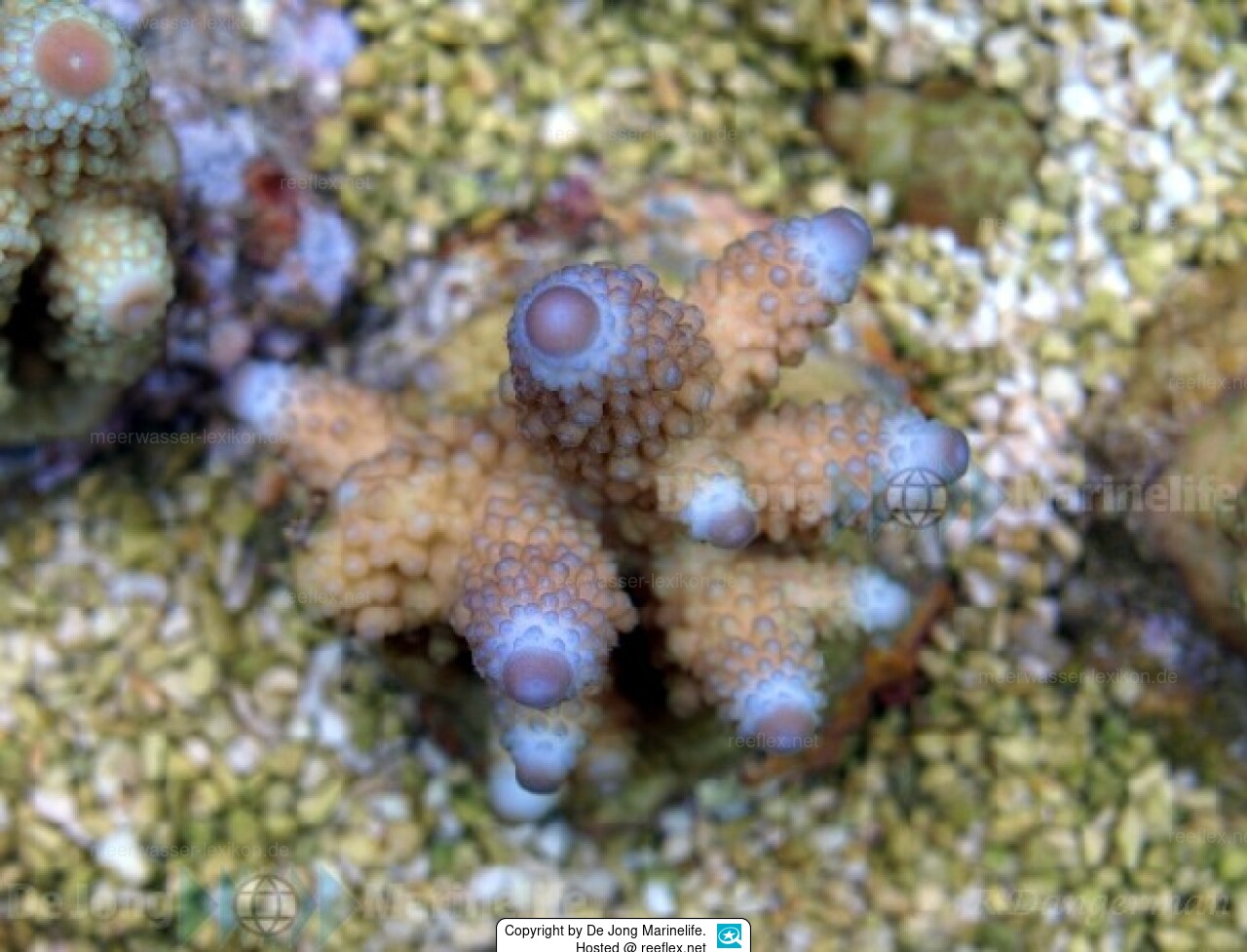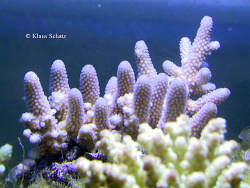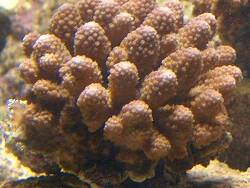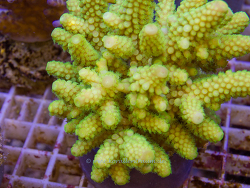Info
Dana, 1846
Corals of the genus Acropora
Stony corals are reef-building, invertebrate, sessile, colony-forming cnidarians that form a calcareous skeleton and live in the world's oceans.
They live primarily on light through their zooxanthellae, but are also capable of capturing plankton with their polyps.
They extract calcium and, to a lesser extent, other elements from seawater, producing several grams of calcium per day,
This is how they formed the coral reefs we know today.
The species of the genus Acropora are often very colorful and their long-term successful keeping has been considered a high art for many years.
They have been kept in aquariums since the end of the 1980s and in the course of the 1990s they were even bred in many cases.
The keeping and asexual propagation via offshoots became popular very quickly, which is why today private aquarists offer coral offshoots in addition to commercial breeders.
The breeding of stony corals is very easy, because they only have to be fragmented. You break off a piece of the mother coral and the offshoot obtained in this way grows (usually glued to a piece of live rock) into its own coral under good conditions, similar to plants.
In hobby circles, stony corals are roughly divided into Small Polyp Scleractinians (small polyp or SPS corals) and Large Polyp Scleractinians (large polyp or LPS stony corals) based on the size of their polyps.
Not all SPS corals are equal in their husbandry requirements; again, there are species that are less sensitive than others.
General:
Taxonomists now consider there to be 18 families of stony corals with a total of over 100 generAcropora
The two genera Montipora (over 70 species - Veron 2000) and Acropora (over 180 species - Veron 2000) are among the most species-rich and numerous.
The care of small polyped stony corals was and is usually far more complex than that of most LPS corals and zooxanthellate soft corals due to the requirements of the corals for water quality and lighting.
Therefore, only with the possibilities of skimming and the use of live rock, the possibility of creating a better water quality arose, as well as with better lighting and better calcium supply, the permanent keeping and reproduction.
Since keeping SPS corals has become an attainable goal for many, zooxanthellate soft corals have hardly been the main focus of most aquarists.
The identification of small-polyped and large-polyped stony corals is not always easy, despite really good works, like the book of Veron, Corals of the World, or the AIMS pages - especially since an unambiguous identification should actually be made on the basis of the calcareous skeleton.
One should also not forget that many animals in the aquarium do not look like they do in nature, and change their appearance due to current, light, as well as other influences.
Among the important parameters:
Light:
All small polyp stony corals from the genus Acropora require very high light intensity.
Therefore, they should tend to be located at the top of the tank with average lighting.
Heat/Cold:
Corals of the genus Acropora will not tolerate water temperatures below 20 degrees or above 30 degrees for extended periods.
Both cases they will acknowledge with bleaching.
Current:
They can tolerate a fair amount of current, although the pump outlet should never be aimed directly at a coral.
Alternating, more turbulent flow conditions are best.
Water parameters:
Trace elements, (calcium 420-440 mg/L, magnesium 1100-1300 mg/L, KH below 8, strontium 8 mg/L). Water changes: at least 5% a week or 10% a month.
Water quality:
Permanently stable and clear water if possible, if necessary carbon filtration or ozonation is advisable to remove yellow substances.
The bucket comparison (2 white containers of the same size, in one freshly prepared water, in the other aquarium water) will quickly show you if your water in the aquarium is as clear as fresh water.
Acropora Steinkorallen do not like to stand in a yellow broth.
Nitrate NO3:
Less than 5 mg/L.
Phosphate PO4:
Less than 0.1 mg/L, better even in the range of 0.01 mg/L.
While large polyped stony corals can usually still cope with higher nutrient values, small polyped stony corals often quickly show a loss of color, or in some cases the growth of the animals is disturbed.
Corals that used to be colorful then quickly turn into an often unsightly brown. The culprit is the higher supply of nutrients.
The more nutrients, the more zooxanthellae are formed and the darker the brown tone of the animal.
If there is a long-term oversupply or imbalance of nutrients, tissue dissolution can occur.
Last but not least:
Let's not forget the wildlife and environmental protection aspect that all coral growers now provide.
The more offshoots, the less removal from the wild.
But there has been a lot of change over the years.
So today corals from aquaculture are offered preferentially and sold as offspring.
Hint:
Acropora humilis can be found in the trade from time to time. Possible colors according to Veron are: purple, blue, brown and cream.
Similar species:
Acropora gemmifera, Acropora monticulosa and Acropora torresianAcropora
Synonyms:
Acropora (Acropora) humilis (Dana, 1846).
Acropora (Lepidocyathus) obscura (Brook, 1893)
Acropora (Tylopora) ocellata (Klunzinger, 1879)
Acropora fruticosa (Brook, 1892)
Acropora guppyi (Brook, 1892)
Acropora obscura (Brook, 1893)
Acropora ocellata (Klunzinger, 1879)
Acropora spectabilis (Brook, 1892)
Madrepora (Lepidocyathus) obscura Brook, 1893
Madrepora (Tylopora) fruticosa Brook, 1892
Madrepora (Tylopora) guppyi Brook, 1892
Madrepora (Tylopora) humilis Dana, 1846
Madrepora (Tylopora) ocellata Klunzinger, 1879
Madrepora (Tylopora) spectabilis Brook, 1892
Madrepora fruticosa Brook, 1892
Madrepora guppyi Brook, 1892
Madrepora humilis Dana, 1846
Madrepora obscura Brook, 1893
Madrepora ocellata Klunzinger, 1879
Madrepora spectabilis Brook, 1892
Corals of the genus Acropora
Hard corals are reef-building, oceanic invertebrates, sessile and colony-forming cnidarians that form a calcareous skeleton. They live mainly on light via their zooxanthellae, but are also able to catch plankton with their polyps. They extract calcium and, to a lesser extent, other elements from seawater, producing several grams of calcium per day. They also formed the coral reefs known today to a large extent.
The species of the genus Acropora are often very colorful and their long-term successful keeping has been considered high art for many years. They have been kept in aquariums since the late 1980s and then even multiplied many times over the course of the 1990s. Cult husbandry and asexual reproduction quickly became popular. Today, in addition to commercial breeders, private aquarists also offer coral offshoots.
The propagation of hard corals is very easy, since they ultimately only have to be fragmented. You break off a piece of the mother coral and the offshoot obtained in this way grows (usually glued to a piece of live rock), similar to plant offshoots, into its own coral stock under good conditions.
Hard corals are divided in hobby circles, roughly based on the size of their polyps, into small polyp scleractinians (small polyp or SPS corals) and large polyp scleractinians (large polyp or LPS hard corals).
Not all SPS corals are created equal in their husbandry needs. Again, there are species that are less sensitive than others.
General:
Taxonomists today assume that there are 18 hard coral families with a total of over 100 genera.
The two genera Montipora (over 70 species - Veron 2000) and Acropora (over 180 species - Veron 2000) are among the most species-rich and numerous.
The maintenance of small-polyp stony corals was and is usually far more complex than that of most LPS corals and zooxanthellate soft corals due to the corals' requirements for water quality and lighting.
With the development of high-performance skimmers and the use of living rock, a much better water quality in the aquarium could be guaranteed. In addition, better lighting and an automated, continuous supply of calcium enabled the corals to be kept and reproduced over the long term.
Since keeping SPS corals has become an achievable goal for many aquarists, zooxanthellate soft corals are of little interest to most aquarists.
Identifying small polyp and large polyp hard corals is not always easy, despite really good reference books like Veron's book "Corals of the World". Ultimately, a clear identification is only possible on the basis of precise examinations of the calcareous skeleton, or by means of complex DNA analyses.
It should also not be forgotten that many animals in the aquarium no longer look like they do in nature and their appearance changes due to currents, light and other influences.
Among the important parameters:
Light:
All small-polyp hard corals from the genus Acropora need a very high light intensity.
They should therefore be placed at the top of the tank with average lighting.
heat/cold:
Corals of the genus Acropora do not tolerate water temperatures below 20 or above 30 degrees for a long time.
In both cases, this will lead to fading.
Flow:
They tolerate quite a good current. However, the pump outlet should not be aimed directly at a coral.
Changing, rather turbulent flow conditions are best suited.
Water parameters:
Trace elements (calcium 420-440 mg/L, magnesium 1100-1300 mg/L, KH below 8, strontium 8 mg/L). Water changes: at least 5% per week or 10% per month.
water quality:
Water that is as permanently stable and clear as possible, if necessary, carbon filtering or ozonation is useful to remove yellow substances.
The bucket comparison (2 white containers of the same size: freshly prepared water in one, aquarium water in the other) then quickly shows whether the water in the aquarium is as clear as the fresh water.
Acropora hard corals don't like standing in a yellow broth.
Nitrate NO3:
less than 5mg/L.
Phosphate PO4:
less than 0.1 mg/L, better even in the range of 0.01 mg/L.
While large-polyp stony corals can usually cope with higher nutrient values, small-polyp stony corals often quickly lose their color or the growth of the animals is restricted.
Corals that used to be colorful quickly turn an often unsightly brown. This is due to the higher supply of nutrients. The more nutrients, the more zooxanthellae form and lead to a dark brown tone in the animal.
If there is an oversupply or an imbalance of nutrients over a longer period of time, this can lead to tissue breakdown and thus to the death of the coral stock.
Last but not least:
Let's not forget the animal and environmental protection aspect that all coral growers are now doing.
The more offshoots, the fewer withdrawals from nature. A lot has happened in this area over the years. Corals from aquaculture are preferred today and sold as offspring.







 De Jong Marinelife, Holland
De Jong Marinelife, Holland













































































































































































